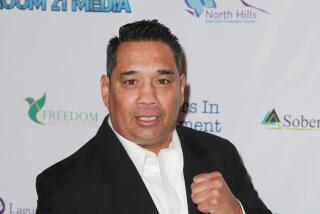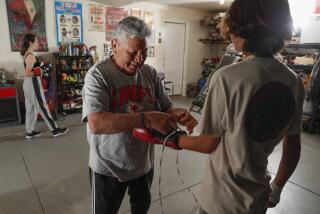AN OLD WARRIOR : McLarnin, 81, Recalls Hard Days of Boxing
- Share via
They shared hard times, those tough, rock-hard young men of America’s Depression, and they fought one another savagely.
Their names alone evoke a richness of the American melting pot and the American dream: Canzoneri, Ross, McLarnin, Petrolle, Apostoli, Zivic . . . and maybe the greatest of them all, Henry Armstrong.
They’re nearly all gone now, the great welterweights and middleweights of the Depression era. Tony Canzoneri, Barney Ross, Billy Petrolle, Fred Apostoli, Fritzie Zivic and Armstrong . . . all gone.
Still with us, however, is Jimmy McLarnin, two-time welterweight champion, who at 81, is happy, wealthy and wise.
He has lived in the same house on a quiet, leafy Glendale street the last 40 years.
Jimmy McLarnin is older than the memories of practically everyone who attends boxing shows in Southern California today. He fought in Los Angeles before there was an Olympic Auditorium. Calvin Coolidge was President when McLarnin was a hungry, 16-year-old making his debut at Vernon Arena in September, 1924.
Today, his only concessions to age are arthritic hands, and a nearly empty house. His wife of 52 years, Lillian, died last year. His four children live in the northwest and British Columbia, and Jimmy talks of selling the old Glendale house and moving closer to his children. “I’m in good health; I’m thankful for that,” he said the other day. “I watch my diet. I’m at 150 pounds now, three pounds over my fighting weight. And I walk two to three miles every day.”
McLarnin talked about the old days, about a special bond the young battlers of the 1930s America shared.
“Of all the hundreds of fighters I came in contact with in my life, I can say I can’t think of a one who I didn’t like and who didn’t turn out to be at least a halfway decent human being,” he said.
“Boxing is a whipping boy for a lot of people, but look at all the guys who made something of themselves with boxing. Look at Jack Dempsey. He was a bum, a hobo. And he became a champion, and a pretty decent human being.
“The fighters in those days . . . we all came up hungry together. None of us had it easy coming up. Our fathers worked like dogs. In a way, we loved each other. I mean, you’d try to beat a guy’s brains out in the ring, but before and after a fight, I admired all the guys I fought. They’d gone through everything I had to go through.”
The old fighter showed a visitor his trophy room. He leafed through a stack of old photographs. He pulled out a faded photo of a group of about 15 young boys, all staring intently into the camera.
“I’m in this picture,” he said. “It’s a group of newsboys in Vancouver, when I was a little kid. Can you find me?”
It was easy. Last one on the right, second row. There was an unmistakable fierceness to the little lean face. The glare from his stare leaped out, from 70-odd years ago.
McLarnin laughed, and showed some old photos from his golf days at Lakeside Golf Club.
“That’s Bing Crosby. That’s Pat O’Brien. Here I am with Spencer Tracy. . . . I got my handicap down to three at one point. I was livin’ pretty good in those days, after I retired from fighting, in 1936.”
McLarnin says he doesn’t pay much attention to the boxing scene today.
“There are so many champions, I can’t keep track of what’s going on,” he said.
James Archibald McLarnin turned pro in Vancouver when he was 15 and had 77 bouts in 13 years. Within 16 months in 1933 and 1934, he won and lost the welterweight championship twice.
At Wrigley Field in Los Angeles, he knocked out Raffaele Capabianca Giordano--known then as Young Corbett III--of Fresno, winning the title the first time.
McLarnin lost the championship a year later to Barney Ross, won it back in the rematch and lost it again in the rubber match.
In 1936, he lost and won decisions with Canzoneri, won a decision over Lou Ambers, and retired.
The list of McLarnin’s opponents reads like a page from boxing’s Who’s Who. He fought ‘em all, as they say. But the old champion was stumped when asked to single out the toughest man he had fought.
“Gosh, so many great fighters,” he said. “I could never say one guy was better than the others. But I will say that Billy Petrolle hit me as hard as anyone ever did. He was a tough, tough guy. He hit me so hard in the second round of my fight (in 1930) with him that afterward I couldn’t remember a thing from Rounds 2 through 7.”
McLarnin lost a decision to Petrolle in 1930, then defeated him twice in 1931.
“And Louis (Kid) Kaplan--oh, could he hit. He knocked me down three times in 1927 and broke my jaw. After the fight (won by McLarnin on a knockout), I remember my teeth didn’t fit together the same, but I didn’t think much about it.
“Three years later, a dentist asked me: ‘How did you break your jaw?’ Kaplan had broken my jaw and I’d never known it.
“Maybe the meanest guy I ever fought was Bud Taylor. He was a vicious . . . , really tough. I fought him in 1925, when I was just a kid and had no business in there with him. I remember the first time I fought him, in Vernon, it was my biggest payday by far at the time, $1,500. He beat me twice and I won one on a foul.
“Barney Ross was a really tough opponent. He was a great boxer and had a great chin. I can remember getting him right on the chin with some of the best shots I ever hit anyone with and he didn’t even blink.
“The greatest fighter of my era, but a guy I never fought, was Harry Greb. I fought on an undercard of his in Oakland, in 1924. He was blind in one eye, and fought you kind of twisted sideways, so he could see you. In his prime, he might have been the best there ever was. He was a middleweight and heavyweights wanted no part of him.”
In talking of the old days, McLarnin frequently refers to the hard work it took to be a world-class fighter. It was a work ethic acquired from a hard-working father, he said.
“My father was a beautiful man,” he said. “He was as hard-working and as talented a man as I ever knew. My father could do anything. He never had a lot of money, but he raised six sons and six daughters and showed all of us what hard work is.”
McLarnin was born in Inchacore, Ireland, and was 3 when his father booked third-class passage to Canada in 1910.
“We went first to Saskatchewan, where my father got a section of land and raised wheat for 15 cents a bushel,” McLarnin said.
“We later went to Vancouver. My father was in the lumber business, the furniture business and he was a butcher. He could even fix shoes.”
In his mid-teens, McLarnin fell under the influence of a popular Vancouver boxing instructor, Charles (Pop) Foster, and thus began a relationship that endured for 40 years.
McLarnin has a framed portrait of Foster on the wall of his den. When Foster died in 1956, he left $200,000 to McLarnin.
“Pop really cared about me, and he brought me along very carefully,” he said. “No fighter ever had a better manager than I did. I was a natural right-hander and he never had to help me with the right. But he spent two years with me getting my left jab ready before I turned pro.”
One of Foster’s tips earned McLarnin his welterweight championship.
“Young Corbett was a great fighter, but he made one mistake--he took me for a pigeon,” McLarnin said.
“Corbett was a defensive fighter, but Pop had noticed he had a habit of leaning forward slightly just before he threw his right hand. So we planned to let him do that a few times early in the fight, sucker him in, then try to catch him with a left hook.
“And that’s exactly the way it happened.”
March 29, 1933. New, three-bedroom homes in West L.A. were going for $3,200. A new Ford V-8 cost $490. It cost 25 cents to see “King Kong” at the RKO Hillstreet. A crowd of 50,000 saw Babe Ruth hit three home runs against the Chicago White Sox at Yankee Stadium the day before, and 15,000 saw Jimmy McLarnin win the welterweight championship at Los Angeles’ Wrigley Field.
The old champion is on his feet now, dancing softly across the carpet. He flicks out left jabs, demonstrating the set-up punches for that knockout.
“He did it once (he leans forward), I watched him carefully--then I let him do it again,” McLarnin said, from his fighting stance.
“And when he did it the third time-- Bing! (he throws a hard, quick left hook) I got him. A perfect punch, a left hook right on the chin. He went down flat, got up but could hardly stand. I knocked him into the ropes, and the referee stopped it.”
McLarnin smiled broadly at the memory, which has always been a sweet one for him because his 71-year-old father, Samuel McLarnin, was at ringside that night in 1933.
But then McLarnin grew frustrated at not being able to remember the referee (George Blake) who awarded him the title that night.
The day after the fight, The Times started the story--”McLarnin Is Ring King”--on Page 1, and described near-riotous conditions when deliriously happy McLarnin fans tried to storm the ring to reach their new champion.
Fifty-six years later, both challenger and champion from that night are still alive. Corbett is 84, suffers from Alzheimer’s disease, and lives in a rest home near Fresno. His wife attributes his illness to head injuries suffered in an auto accident in the 1950s.
McLarnin earned between $700,000 and $800,000 in Depression dollars in his fighting days. His biggest purse was $60,000 for the final fight against Ross. He earned $50,000 in 1929 for beating Sammy Mandell in Chicago. During the 1930s, he said, he never earned less than $20,000 for a fight.
And earn it he did, he said, proudly. Always, the work ethic.
“I got a dollar for my first fight and $25,000 for my last one, and in between there was a lot of tough, hard work,” he said.
More to Read
Go beyond the scoreboard
Get the latest on L.A.'s teams in the daily Sports Report newsletter.
You may occasionally receive promotional content from the Los Angeles Times.










